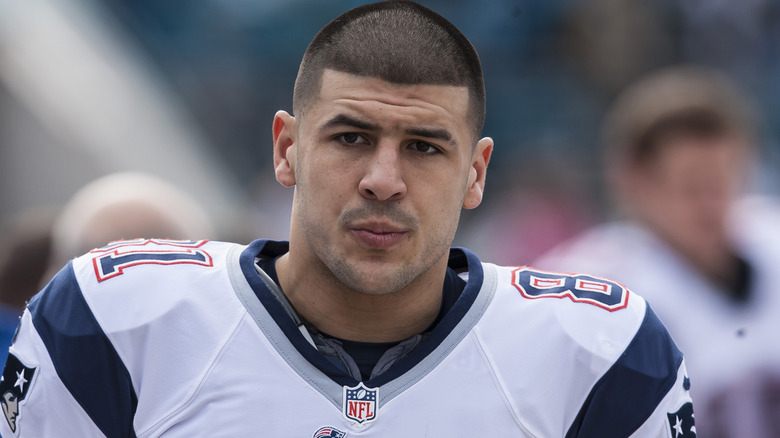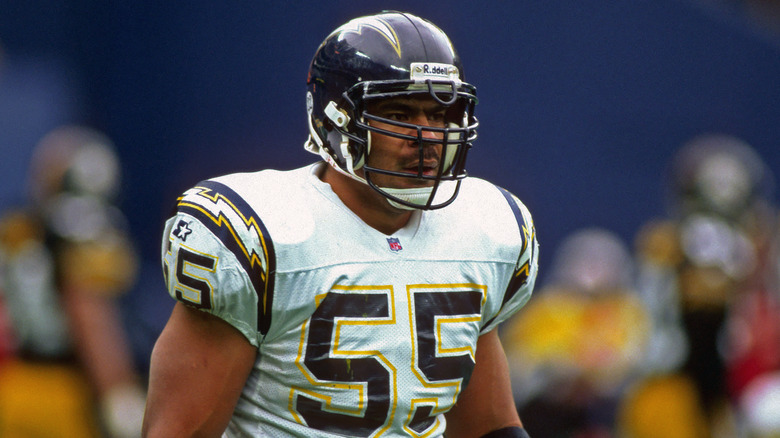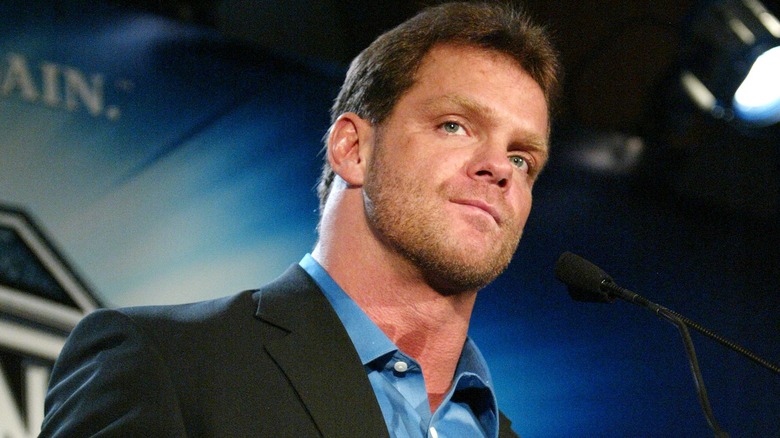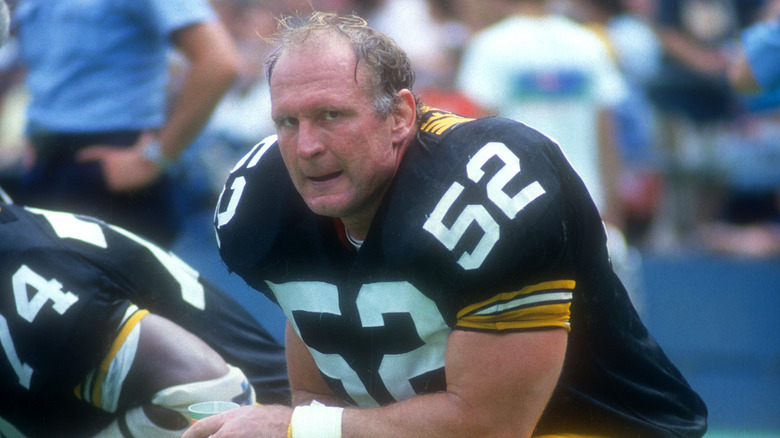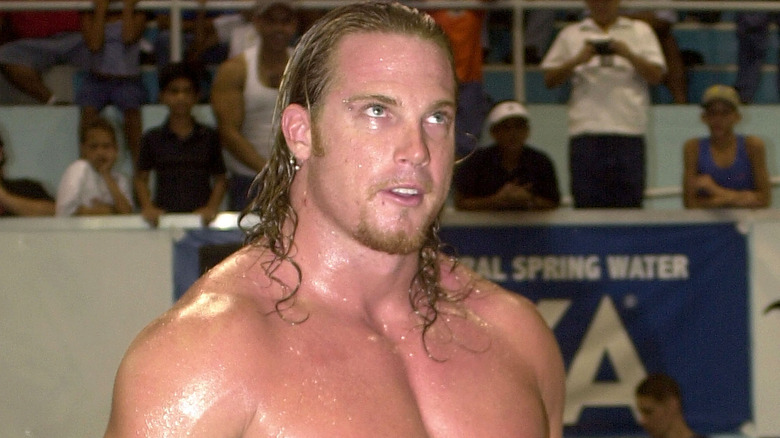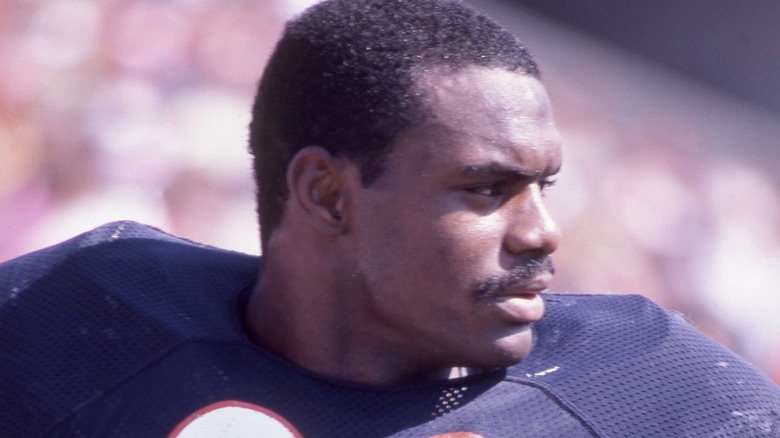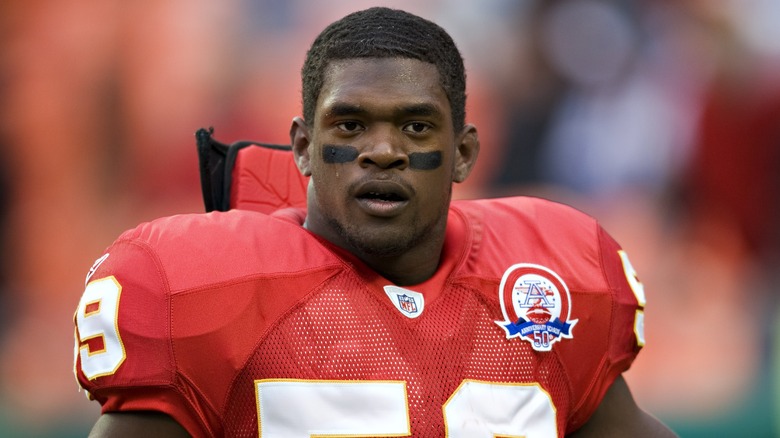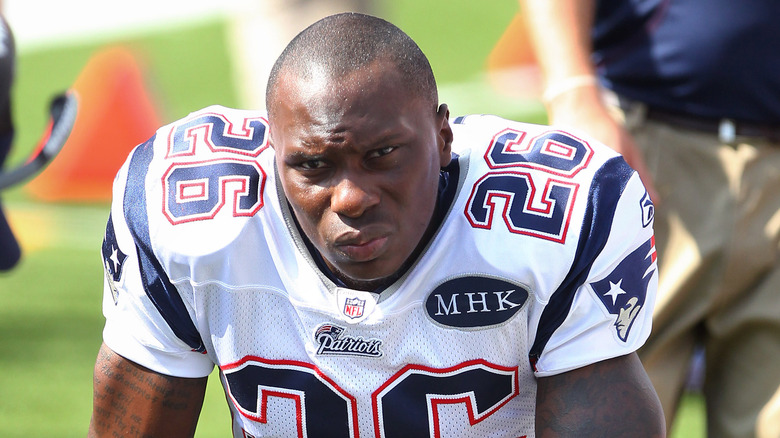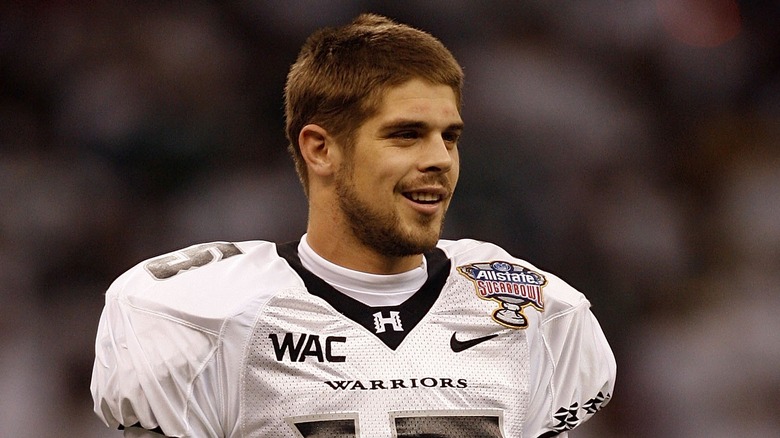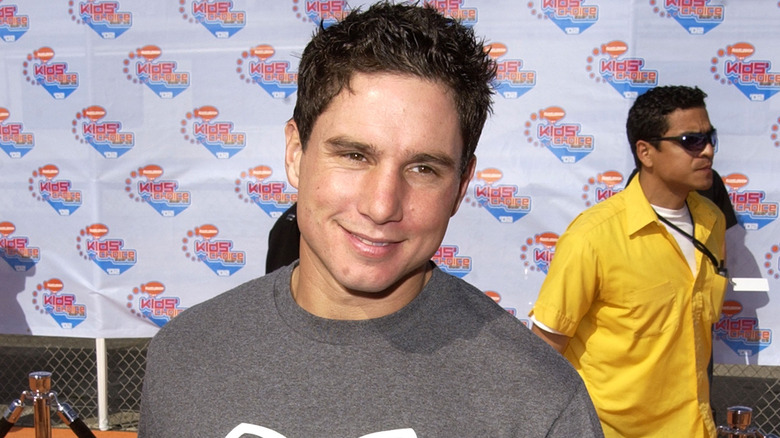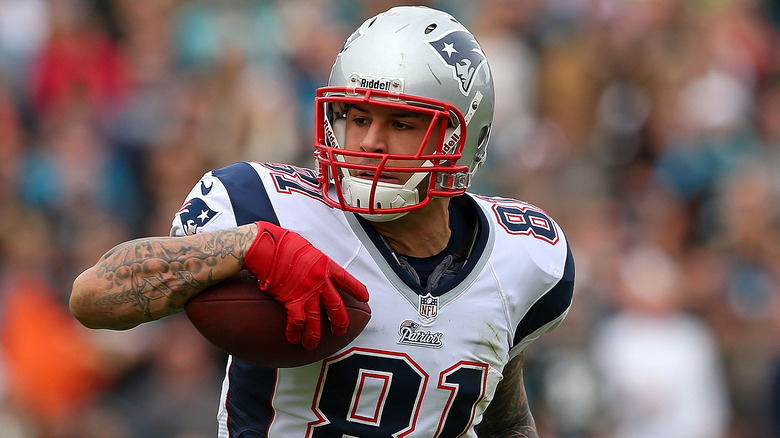These Athletes Who Died Young Share A Chilling Connection
It's all too common for high-profile athletes to die at a young age. While these individuals' causes of death tend to vary, the past few decades have seen an increase in deaths linked to one particular condition — chronic traumatic encephalopathy, or CTE.
Although it was first discovered in the late 1920s — loosely known as "punch-drunk syndrome" because of how it was commonly observed in boxers — it was only in the early 21st century when CTE reached mainstream consciousness as posthumous diagnoses of the disease became commonplace. Its symptoms include cognitive and behavioral changes such as short-term memory loss, impaired judgment, depression, anxiety, aggression, and mood swings, all of which are issues that can lead to disturbing consequences if left unchecked.
What follows is a list of athletes across different contact sports who all died at the age of 50 or younger and were later confirmed, or at the very least suspected, to have suffered from CTE. They all dealt with some form of traumatic brain injury during their careers, as well as some combination of the aforementioned symptoms and others in the years leading up to their death.
Junior Seau
Junior Seau was one of his generation's most dominant defensive players, making the Pro Bowl 12 times and getting selected to six All-Pro teams. The linebacker spent most of his 20-year career with the San Diego (now Los Angeles) Chargers, retiring at the age of 40. Sadly, it wasn't long after his last NFL game when in October 2010, Seau was arrested for domestic violence; just hours later, he drove his Cadillac SUV off a cliff, with officers finding no evidence that he was under the influence. The would-be Pro Football Hall of Famer died by suicide on May 2, 2012, at just 43 years old.
Seau's son, Tyler Seau, revealed to Sports Illustrated in 2013 that he wasn't surprised that the NFL legend was found to have CTE. "I don't think any of us were aware of the side effects that could be going on with head trauma until he passed away," he said. "We didn't know his behavior was from head trauma."
Both Tyler Seau and his mother, Junior's ex-wife Gina, told the outlet that the Chargers icon dealt with symptoms such as depression, mood swings, insomnia, and forgetfulness. "He emotionally detached himself and would kind of `go away' for a little bit," Tyler explained. "And then the depression and things like that. It started to progressively get worse."
Chris Benoit
Oftentimes referred to as "The Crippler" during his in-ring days, Chris Benoit's story is one of triumph and tragedy. He made up for his lack of traditional size for pro wrestling with technical precision, and when he won the WWE World Heavyweight Championship at WrestleMania XX in 2004, his touching celebration with real-life friend Eddie Guerrero marked the culmination of a wrestling career, during which he had repeatedly challenged the narrative that smaller grapplers don't get booked to win world titles. Three years later, the unthinkable happened.
On June 25, 2007, the 40-year-old Benoit, his wife, Nancy, and their 7-year-old son, Daniel, were found dead in their Fayetteville, Georgia, home, following an apparent murder-suicide. Initially, it was believed that Benoit's actions were driven by steroid misuse, but in September 2007, Sports Legacy Institute researchers found that his brain was so damaged from multiple concussions that it was akin to that of an 85-year-old. The organization's president, former WWE Superstar Christopher Nowinski, told The New York Times that Benoit was aware of the toll that wrestling was taking on him. "Chris personally told me that he had had more concussions than he could count," he said.
In an interview with ABC's Good Morning America, the wrestler's father, Michael Benoit, described his son as someone whose behavior was completely out of character. "First we needed an understanding," he said. "The person that did this is not the man we know and love."
Derek Boogaard
In an NHL stint that spanned just six seasons, Derek Boogaard established himself as one of the league's most feared enforcers, someone who barely figured in the offense but wasn't afraid to spend time in the penalty box for roughing up opposing players. He was only 28 years old when he died of a drug and alcohol overdose on May 13, 2011, and five months later, doctors found that the former Minnesota Wild and New York Rangers player had CTE.
Friends and family spoke to The New York Times for an in-depth piece on Boogaard's life, career, and untimely death. They pointed out several warning signs that hinted something wasn't right with the burly left-winger in the last few years before his passing. "His demeanor, his personality, it just left him," said former Wild teammate John Scott, recalling the first time Boogaard was sent to the penalty box in the 2009-10 NHL season. The outlet also noted that Boogaard, once easygoing outside the rink, had become forgetful and impulsive, with a tendency to make large and unnecessary purchases.
Boogaard also dealt with erratic mood swings toward the end of his life. His father, Len Boogaard, talked about how Derek, then suffering from persistent headaches, was rather emotional when they met in New York early in 2011. "I had to hold him," the older Boogaard said. "It was like when he was younger, when he was a little kid growing up. He just sobbed away uncontrollably."
Mike Webster
Well before CTE became widely known, Mike Webster became the first NFL player officially — and posthumously — diagnosed with the condition. A Super Bowl-winning center who spent the bulk of his 17-year professional career with the Pittsburgh Steelers, Webster was one of the finest offensive linemen of his era and was inducted into the Pro Football Hall of Fame in 1997. Unfortunately, that year it was also reported that the Steelers icon was unhoused and unemployed, and had been dealing with depression in the years following his retirement.
Webster died of a heart attack at the age of 50 on September 24, 2002, and his death changed sports history because of what would-be CTE expert Bennet Omalu discovered while performing an autopsy on the late NFL lineman. "I saw changes that shouldn't be in a 50-year-old man's brains, and also changes that shouldn't be in a brain that looked normal," he told PBS' Frontline in a 2013 interview.
Indeed, it wasn't just depression and being unhoused that Webster was dealing with after he retired from the NFL. In her book "Concussion," Jeanne Marie Laskas wrote (via The Atlantic) that Webster's reaction to life after football was "extreme," as he would exhibit unusual behaviors such as randomly yelling threats at strangers, forgetting to eat, relieving himself in the oven, and trying to repair his fallen teeth by gluing them back on.
Andrew Martin aka Test
Andrew Martin first came into prominence in the late 1990s, when he joined the then-WWF's roster as a kayfabe Mötley Crüe bodyguard simply known as Test. While his usual mid-card status kept him from serious world title contention, Martin won his share of championships as a WWF/WWE Superstar, including the Intercontinental, European, and Tag Team belts. However, his life outside the ring was anything but smooth, as he racked up multiple DUI arrests in the late 2000s and ran afoul of WWE's Talent Wellness Program. On March 14, 2009, Martin became yet another tragic example of a wrestler who died before the age of 40, dying of a drug overdose at 33 years old.
In December 2009, Bennet Omalu, at that time serving as co-director of the Brain Injury Research Institute, told ESPN that Martin was the second pro wrestler after Chris Benoit to receive a posthumous CTE diagnosis. He added that the former WWE talent manifested some symptoms of the condition. "When I talked with his parents, they confirmed manic depressive behavior," Omalu said. "They said he just couldn't cope. They didn't think it was their son. They didn't understand what had happened."
Dave Duerson
One of the more tragic facts of the Chicago Bears' history is that many players from the Super Bowl-winning 1985 team had a hard time acclimating to post-football life. While most longtime fans might immediately bring up colorful defensive lineman William "Refrigerator" Perry's downfall, there's also the sad case of safety Dave Duerson, a four-time Pro Bowler who played seven of his 11 NFL seasons in Chicago and won a second Super Bowl in 1990 with the New York Giants. While he outwardly seemed to live a productive and happy life after he retired from pro football, there were more than a few signs of something darker lurking within before his death by suicide at age 50 on February 17, 2011.
According to Duerson's ex-wife, Alicia, these signs began to manifest around 2005, as he began to lose his critical thinking ability, experience mood swings, and suffer frequent and intense headaches. In February of that year, the former Bears star resigned from his alma mater Notre Dame's board of trustees after he was charged with assault on his then-wife, and by 2007, he had lost his business and was separated from Alicia.
Commenting on Duerson's advanced CTE, Boston University neuropathologist Ann McKee told The Guardian that the damage he suffered was quite significant for a man his age. "To show this degree of degenerative disease at that young age is quite extraordinary," she added.
Jovan Belcher
As a University of Maine football standout in the late 2000s, Jovan Belcher was described as a soft-spoken individual who participated in various extracurricular activities, including the Male Athletes Against Violence movement and membership in a group that designed the school's Martin Luther King Jr. memorial. He was a hard-working player who joined the Kansas City Chiefs as an undrafted rookie in 2009, and became a starting linebacker the very next season. As such, it was particularly shocking when on December 1, 2012, he fatally shot his girlfriend, Kasandra Perkins, before driving to the Chiefs' home field and taking his own life in front of his head coach and general manager. Belcher was 25 years old.
Friends and colleagues who spoke to ESPN about the murder-suicide said that Belcher was the last person they'd expect to commit such a horrific crime. "Completely out of character. He was charitable, polite, articulate — and something went crazy wrong," his agent, Joe Linta, told the outlet.
Separate wrongful death lawsuits filed against the Chiefs by Belcher's mother, Cheryl, and lawyers representing his infant daughter, alleged that the linebacker showed changes in mood and behavior, hinting that he might have been suffering from CTE at the time of the murder-suicide. This was corroborated by neuropathologist Dr. Piotr Kozlowski, who, in a report obtained by ESPN, noted that Belcher's brain had deposits of tau protein — a key feature of the condition.
Shannon Spruill aka Daffney
Better known to fans as Daffney Unger or just plain Daffney, Shannon Spruill was a respected veteran of women's wrestling, having competed primarily in WCW and TNA while typically working a goth-themed gimmick. Her hard-hitting, high-risk style made her a fan-favorite competitor, and she even won WCW's traditionally male Cruiserweight Championship in May 2000. Unfortunately, her intense in-ring performances also led to several injuries, including multiple concussions during her time competing in TNA.
The long-term effects of these brain injuries on Spruill's well-being didn't fully hit home until the night of September 1, 2021, when she went on Instagram Live and was seen holding a gun while tearfully telling her fans how she felt. "Do you guys not understand that I am all alone? Do you not understand that?" she asked (via Fox News). She then reminded viewers that her brain "goes to Boston" — a reference to Boston University's traumatic brain injury research program. The day after, Spruill was found dead in her Georgia home, with authorities ruling that the 46-year-old wrestler died by suicide.
While it hasn't yet been confirmed whether Spruill suffered from CTE, her autopsy revealed that she "had a known medical history of bipolar disorder and multiple previous head injuries." Per her final wishes, her brain was also taken to Boston University for CTE testing and research.
Phillip Adams
Throughout the course of six NFL seasons, Phillip Adams was a journeyman defensive back who suited up for six different teams and started 11 of the 78 games he played in. He was six years removed from his last NFL snap on April 7, 2021, when he made the headlines for the worst possible reason. Adams, then 32 years old, shot and killed six people in Rock Hill, South Carolina, including a local doctor, his wife, and two of their young grandchildren, before taking his own life.
Adams, who was sidelined twice with concussions while playing for the Oakland (now Las Vegas) Raiders, had been dealing with memory problems and had trouble sleeping, among other issues. Ann McKee, the Boston University brain injury expert and head of the school's CTE Center, told The New York Times that the defensive back had an "unusually severe" case of the disease for someone in their early 30s. "I don't think he snapped," she explained. "It appeared to be a cumulative progressive impairment. He was getting increasingly paranoid. He was having increasing difficulties with his memories and he was very likely having more and more impulsive behaviors."
Colt Brennan
During the mid-2000s, University of Hawaii standout Colt Brennan was one of college football's finest quarterbacks, setting an NCAA record for most touchdown passes thrown in a season and finishing in the top 10 in Heisman Trophy voting in 2006 and 2007. Despite putting up huge numbers in college, Brennan lasted until the sixth round of the 2008 NFL Draft, where he was selected by Washington. Due to injuries in what would have been his rookie year, he never took a regular-season snap in the NFL, and he bounced around various football leagues after he got cut by Washington.
Brennan's lack of pro-football success was also caused by a traumatic brain injury he incurred in a 2010 vehicular accident. It also didn't help that he racked up an arrest record and developed issues with alcohol and drug misuse. Speaking to ESPN, Colt's father, Terry Brennan, said that the accident might have played a part in the quarterback's myriad personal issues. "It seemed to have an effect on him to where he just found himself going from one bad spot to another bad spot," he said.
Brennan was only 37 when he died of a drug overdose on May 11, 2021. Nine months later, researchers said that the former Hawaii signal-caller did indeed have CTE in some form, though it was difficult to determine its severity due to the nature of his death.
Dave Mirra
BMX rider Dave Mirra was a household name for extreme sports fans in the 1990s and 2000s, winning at least one X Games medal in his sport from 1995 to 2009. He also incurred a number of scary injuries during his career, including his share of concussions; that's not yet taking into account the time when he fractured his skull after getting hit by a car in the early '90s.
Mirra's loved ones began to notice changes in the BMX icon's behavior following his retirement from the sport. He became forgetful and unusually emotional, and would even burst into tears during everyday conversations. After meeting with friends at a restaurant in his hometown of Greenville, North Carolina, on the morning of February 4, 2016, the 41-year-old Mirra drove home and died by suicide. In May of that year, doctors confirmed that he had CTE, making him the first action sports athlete diagnosed with the disease.
In an interview with ESPN The Magazine, Mirra's widow, Lauren, went into detail about the changes she observed in her husband in the final year of his life. "He wasn't able to be present in any situation or conversation, so it was hard to be in a relationship with him to any degree," she said. "He was lost. I looked straight through him on a few occasions. And I was like, 'Where are you? Where are you? What is wrong?'"
Aaron Hernandez
There isn't much that hasn't been said about former New England Patriots tight end Aaron Hernandez, who died by suicide while serving prison time for the 2013 murder of his friend, Odin Lloyd. He was only 27 years old at the time of his death on April 19, 2017, and had an extensive criminal record dating back to his time playing for the University of Florida Gators. Hernandez was also found to have the worst case of CTE ever recorded for a person in his age range, as confirmed by Ann McKee.
"In this age group, he's clearly at the severe end of the spectrum," McKee told The Washington Post. "There is a concern that we're seeing accelerated disease in young athletes. Whether or not that's because they're playing more aggressively or if they're starting at younger ages, we don't know. But we are seeing ravages of this disease, in this specific example, of a young person." She also explained that Hernandez had a genetic marker that might have played a role in the severity of his CTE and how easily he developed the condition.
If you or anyone you know is struggling or in a crisis, needs help with addiction issues, may be the victim of child abuse, or is dealing with domestic abuse, contact the relevant resources below:
- Call or text 988 or chat 988lifeline.org.
- The Substance Abuse and Mental Health Services Administration website or contact SAMHSA's National Helpline at 1-800-662-HELP (4357).
- The Childhelp National Child Abuse Hotline at 1-800-4-A-Child (1-800-422-4453) or contact their live chat services.
- The National Domestic Violence Hotline at 1−800−799−7233. You can also find more information, resources, and support at their website.
